#habitis
Explore tagged Tumblr posts
Text
Rewriting Your Life

View On WordPress
#bad habits#communicating creatively#conversations#cost#environment#good habits#habitis#humanity#I will#ideas#inspiration#internal#journey#life#light#new course#Poem#poems#Poetry#reexamining#rewrite#rewriting#shedding#starting#sunrise#thoughts#uncovering#within
3 notes
·
View notes
Note
I'm happy it's a good day for you! Even if you failed one test it's good you can retake it.
It's good to see others happy and enjoy this pic of Salem being cute for good vibes (okay so as im typing this salem jumped onto the chair armrest and scared the shit out of my sis and both jumped -and are ok so thats the only reason i found this funny- out of their skins and Salem did a flail of cat vs cucumber thing and my sister just screamed oh shot and had to take a few deep breaths before she started laughing. Salem sprinted around the room a few times before eating lol)
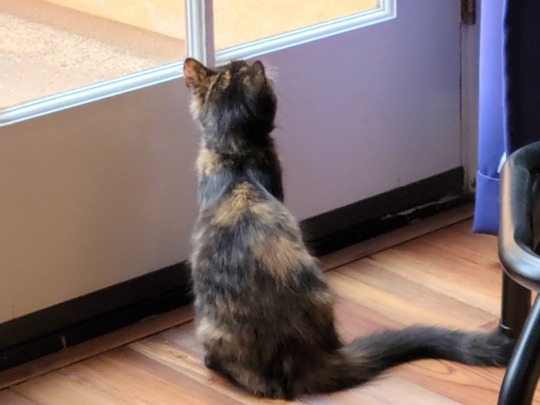
SALEM !!!!!
and yea the way exams work here u can retake them 2 times every semester. so its like meh. i have 2 more chances yknow. but i wont need the third one, i know what they expect now. cant catch me off guard! (they didnt catch me off guard this time either i simply had no motivation to study until the day before-)
please look at this amazing ingredient prep i did today im so proud
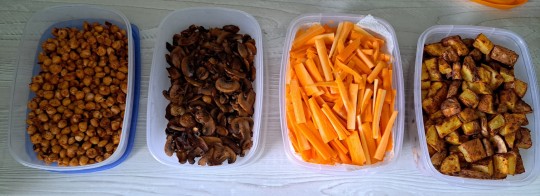
what u cant see is my HEAP of lettuce in the fridge lol i cleaned 2.5 heads of ~butter lettuce~ (its regular lettuce for me, its whats cheapest lol didnt even know it had a cool name like that)
salads arent gonna take me an hour to make now... and trust ive been SO into salads im eating this shit every single day and that one hour can now go towards better things !
#so yeah#and like#ive been feeling pretty great lately#in general#like yeah im a little messed up and detached from reality from exams#but i dont think im like full blown psychotic as i thought i'd be#and im maintaining my lil habity#s#walking and exercising and good hygiene stuff and like#yeah..#and i just did 2 batches of laundry yesterday. and today i ironed#I JUST FEEL SO GOOD AND PRODUCTIVE#irlshaped
7 notes
·
View notes
Text
ˏˋ°•*⁀➷ 「 @espectres liked for a song lyric starter !! 」 winter coats by aaron west and the roaring twenties

things had been hard, and trying to explain it to people that weren't there for it always felt... odd. promising to show his friend the classroom he was in for the last year felt refreshing kind of, he'd been avoiding it for a little bit. but the students bought it and they all owned it... so they could come any time they wanted. they decided to get some food and bring it up, try and help nagisa think about the happy versus the bad.
nagisa got there first... using his copy of the key to open the front door, walking to his desk and placing down his food. he stared at the chalkboard, the stray drawings of their teachers and some of the students up on it. some lessons they were in the middle of, english lessons and some science up on there. he tried to do what his new friend was encouraging him to... to look at the year with fondness, not dismay.
hearing the sliding door open from behind him, nagisa went to open up the other sliding door that lead to the courtyard that they used for training behind the classroom. sitting at the steps that followed a few feet away, he looked out at the overgrown grass over the once dirt field that the teacher leveled for them so they could train.
he went into the plastic bag he had and took out a dorayaki and put it next to him for shou to take when he was ready to sit down. instead of a frown, nagisa was smiling, looking out as he thought about the past year and some of their antics.
❝ you know, it got so hot during the summer, that we have a pool back there somewhere in the woods, i wonder how bad that water is now. ❞

#「⑆」 i wonʼt say a word until you stop breathing 🗡️ in character 「⑆」#「⑆」 it has more to do with me killing him than it ever did protecting myself 🗡️ closed rp 「⑆」#「⑆」 youʼll stay as a reminder of how fucked this world can be 🗡️ post verse 「⑆」#do you know how long it took me on shuffle to get to a somewhat happy song#i dont think you understand habiti it took me a whole day to figure it out#espectres#the song is ab the lead singer takling to his sister ab the hardships they've had... and wanting to be with her now and be like the warmth.#of a winter coat through her hard times.... talking ab how proud their dad would be ??? screams
1 note
·
View note
Text
Who bought the large ham socks 😭😭
#anyone want to own up#it was a few months ago but i assumed the person would come forward when they received them#maybe it will remain a mystery.... maybe not...#it all depends on that one secret person#they might not even be on tumblr but i genuinely dont know how anyone would find my redbubble from elsewhere????#who are you#also this entire thing is light hearted dont feel pressured if you want to keep your shopping habity private!!!!!you dont have to tell me!!!#whoever you are i hope i haven't made you uncomfortable
0 notes
Text

this sounds like a tumblr text post to me
1 note
·
View note
Text

"I haven't slept in like a week Matthias." Juri replied. "Do you have a burner phone, spare sim, and extra survival supplies." He asked. "I'm going off the grid for a while."
@exitiumstarters

"Is there a reason you're being so antagonising so early in the day?" there's a scoff as he sits up, not at all in the mood for whatever's about to be answered back.
55 notes
·
View notes
Text
The Back Pearl of Braavos and 16th century Venetian Fashion:
There is a common consensus among fans that Braavos - a city sited on a group of small islands that are linked by bridges and walkways, divided by canals, channels and waterways of varying size - is heavily inspired by Italian mercantile/maritime republics, of which Venice is the most famous.
Furthermore, the canal-based, inter-connecting island architecture is not the only similarity between Braavos and Venice; both cities are famed for their courtesans.
Indeed in 16th century, Venice was famed for its many elaborately dressed and coiffed courtesans; Veronica Franco (1546–1591) is a famous example! She developed her position in Renaissance Venetian society as a cortigiana onesta (Honest Courtesan), known for her notable clientele, feminist advocacy, literary contributions, and philanthropy.
Her fictional parallel in ASOIAF could be Bellegere Otherys II - one of the famed courtesans in Braavos (the other being Daughter of the Dusk). We know Bellegere comes from a family of courtesans, bearing the title of Black Pearl of Braavos - a moniker borne by a descendant of Bellegere Otherys I, the first Black Pearl, a pirate queen who became a mistress of Aegon IV Targaryen.
The eldest bastard daughter of King Aegon IV and Bellegere, Bellenora Otherys, became a courtesan under the same name. Bellenora's descendants became courtesans as well, each eventually bearing the name "Black Pearl".
We can also assume that Bellegere is rather wealthy, owning her own barge and servants to pole her to trysts and when purchasing three cockles from Arya, who is disguised as Cat of the Canals, paying ten times what the cockles are worth. This wealth is directly reflected in her clothing!
"She was so lovely that the lamps seemed to burn brighter when she passed. She had dressed in a low-cut gown of pale yellow silk, startling against the light brown of her skin. Her black hair was bound up in a net of spun gold, and a jet-and-gold necklace brushed against the top of her full breasts." (TWOW, Mercy)
The aforementioned "low-cut gown" immediately brings to mind the 16th century gowns worn by Venetian courtesans!
Look at this art print of a Venetian Courtesan (Cortigiana Veneta) published by Pietro Bertelli in 1591.
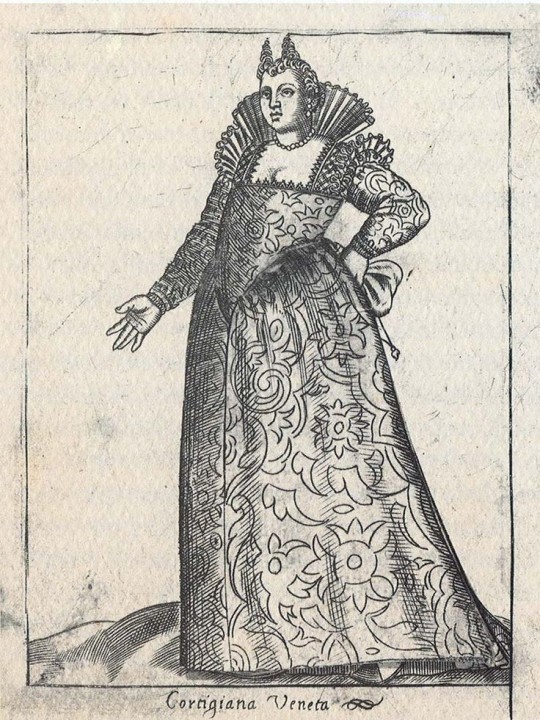

Notice the incredibly low and exposed neckline of the gown!
It is important to mention, however, that not only courtesans dressed this way. Venetian noblewomen of the 16th century also bared their breasts in keeping with the fashion of the day.
For example, look at this art print of a Venetian Bride (Sposa Veneta), also by Pietro Bertelli. There is virtually no difference; perhaps that is why the civic authorities decried the courtesans' deliberately misleading resemblance to 'honest women.'
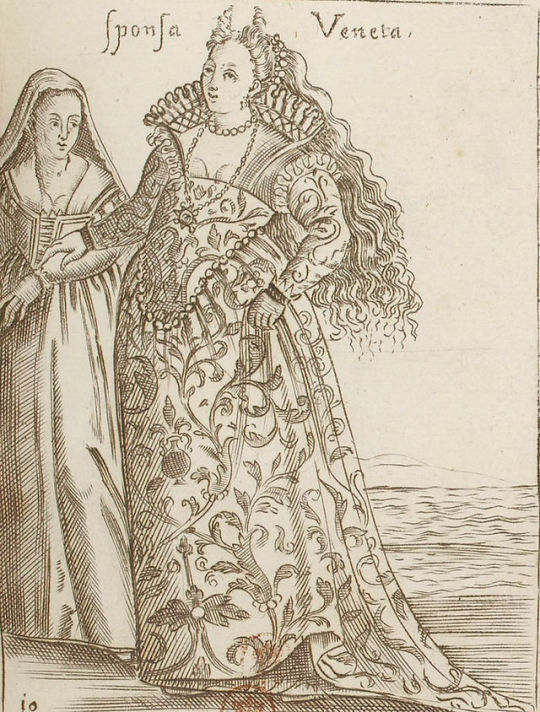
In some portrayals, the Venetian woman's neckline opens almost immediately below the breast!
In Dress of Venetian Women (Habiti delle Donne Venetiane) ca. 1591–1610, the engravings done by Giacomo Franco show ornately dressed courtesans and respectable women, all of whom sport very low cut bodices.
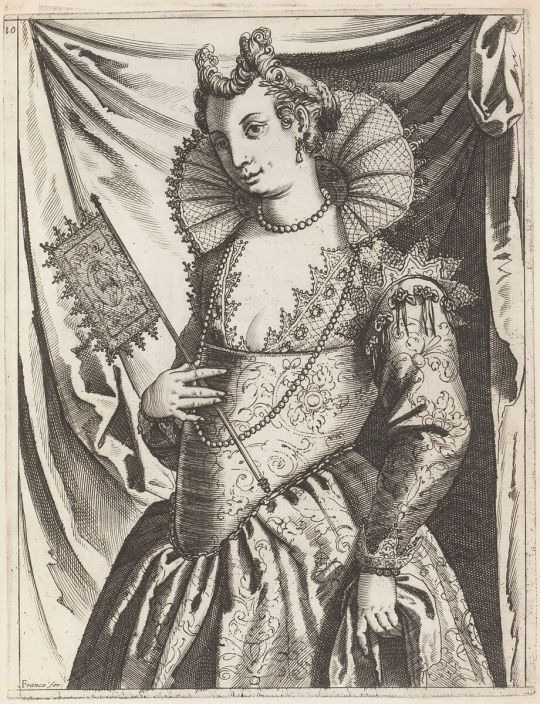
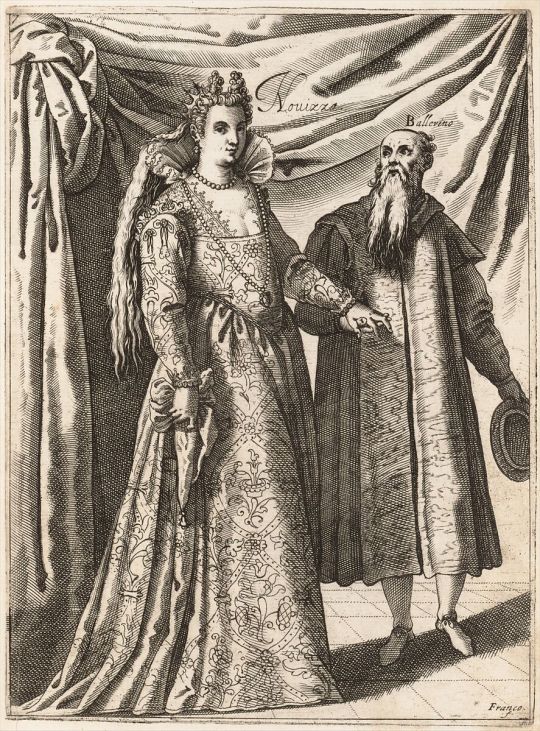
In the second plate we see a depiction of parentado, or the ritual presentation of a bride to her relations. Here, a bride in a richly embroidered dress wearing pearls and a bejeweled crown is presented by her ballerino, a dance instructor who prevented the woman from toppling over in her chopines, or platform shoes.
In conclusion, in depicting Bellegere Otherys - the Black Pearl of Braavos - I would most definitely illustrate her wearing a gown inspired by 16th century Venetian dress (worn by both courtesans and noblewomen). She'd look rather striking I think.
73 notes
·
View notes
Text
16th c. Costume Books, a Problematic Source for Dress History
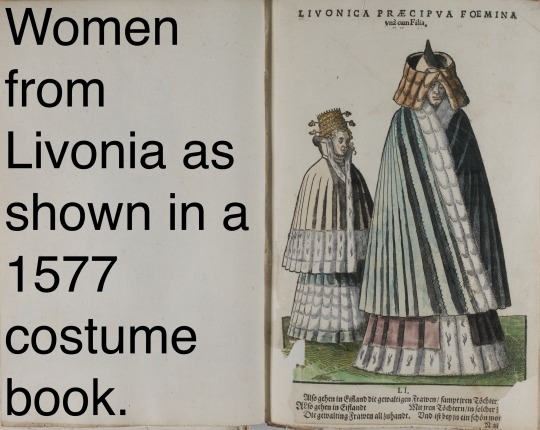
But did they really dress like this?
Costume books and costume albums are a popular source for dress historians, historical costumers, and reenactors researching 16th and early 17th c. Europe. There are good reasons for this. They are primary source documents (at least sometimes), and they show the clothing of cultures and social groups that are difficult-to-impossible to find in other types of period art, like the Irish and rural peasants. Examples of these books include Trachtenbuch des Christoph Weiditz, Habiti antichi et moderni di tutto il Mondo di Cesare Vecellio, and Théâtre de tous les peuples et nations de la terre avec leurs habits et ornemens divers. These books are, however, deeply problematic as a dress history source for several reasons. In this post, I will discuss the ways they are problematic and how those of us researching historical dress can gain a better understanding of what the people shown in these books were actually wearing. I have broken down the problems with using these images into 4 areas.
Embodied biases:
The creators of these books were, at least sometimes, prejudiced against the cultures they were portraying, and these biases may have affected how they characterized these cultures. Hans Weigel, author of Habitus praecipuorum populorum, characterized his native German fashion as modest and virtuous and characterized elaborate Italian fashions as decadent and corrupt. Weigel considered these 'strange' foreign fashions a threat to the 'civilized' German fashion he favored (Bond 2018). This bias might have motivated Weigel to idealize his portrayal of German fashion or to exaggerate the strangeness of Italian fashion in order to scare his readers away from trying it.
Weigel's dislike of flashy foreign fashions seems mild in comparison to the bigotry of some of his peers. Flemish artist Lucas de Heere and French artist François Desprez both labeled the Scottish 'savages' in their books. Jost Amman's description of a purported Turkish sex worker in the German edition of Gynaeceum, sive Theatrum mulierum, is appallingly bigoted:
"A Turkish Wh*re: This is a prostitute, who sells her impure body for dirty money to a lover that pleases her. With the earnings of this sin she dresses herself prettily and beautifully, in order to attract the Turks even more easily with her false ornaments." (translation from Ilg 2004)
Considering the blatant bigotry he shows here, I wouldn't anything about trust Amman's depictions of sex workers, Turks, or any other non-Western Europeans. Or any other women, really.
Sights unseen:
Even when costume book creators weren't actively trying to perpetuate their biases through their work, their ignorance could still cause problems. These artists did not always visit the countries whose costumes they painted. They relied on other artists' work or even just verbal descriptions to fill in the gaps in their knowledge. The resulting images can distort the cut, construction, and material of the clothing.
For example, the Turkish women in this original woodcut by Pieter Coecke van Aelst are wearing shawls or scarves with long fringe wrapped around their heads and shoulders. In the Christoph von Sternsee costume album's illustration based off Coecke van Aelst's print, the fringed shawl has become a strange, tailored hood with a panel of pleated cloth attached to either it or the gown below.
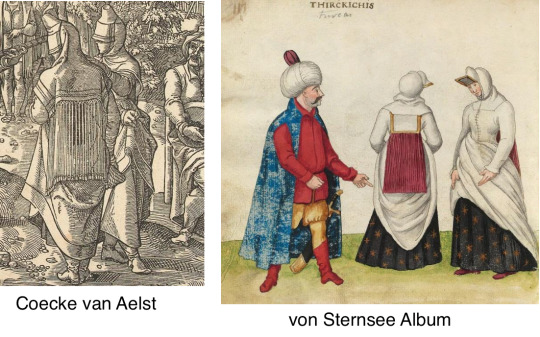
(Coecke van Aelst's woodcuts were identified as the source for the von Sternsee album's illustration in Katherine Bond's 2018 dissertation.)
Copy of a copy of what?
In spite of the problems it causes, copying from other artists' work was common in costume albums (Bond 2018). Considering that the artists did not visit all the cultures they illustrated, this is unsurprising. Some images were copied repeatedly, and the artist misunderstanding the source material wasn't the only source of distortion. Artists also made up details to compensate for bare-bones source material.
This simple line black-and-white print of an Irish woman wearing a léine (linen tunic), brat (Irish mantle), and headwear was used by several artists, all of whom made changes and additions. The first copy in this post is the most faithful to the original, but it still adds long sleeves and eyelet holes on the neckline to the léine. The coloring of the headwear suggests a wool hat crested with a tuft of horsehair and having a linen roll at the bottom. The coloring also gives the brat a contrasting lining.
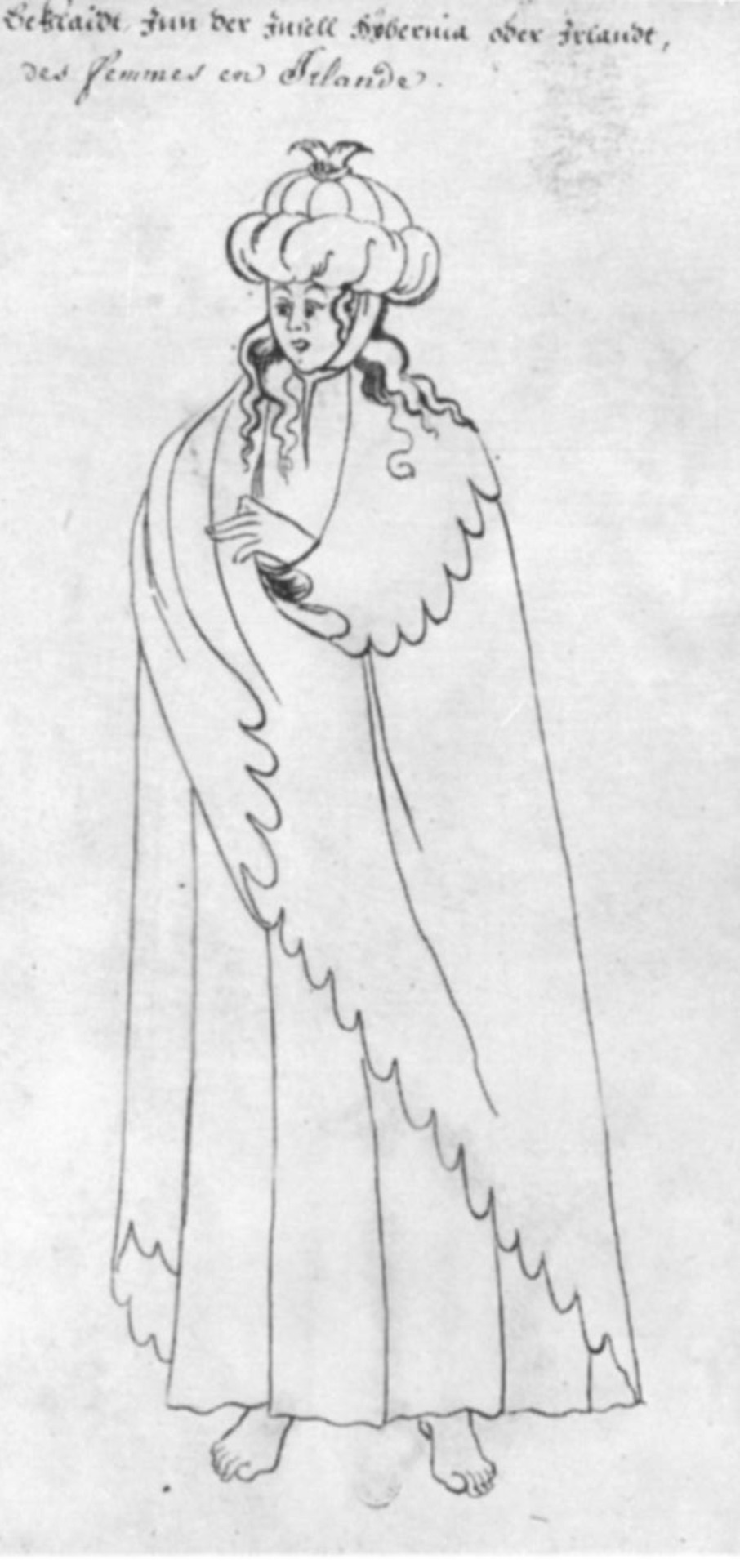

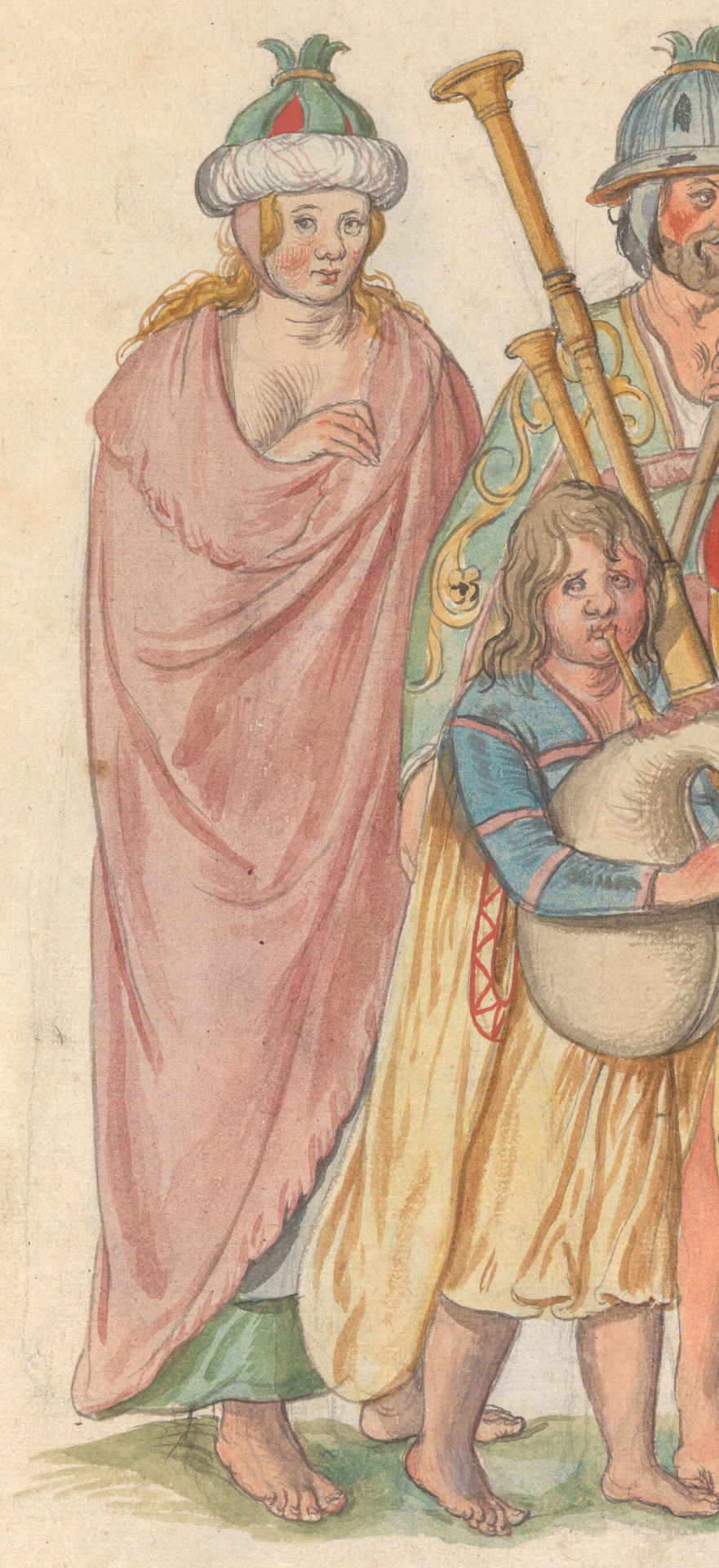
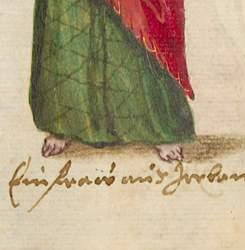
The second knockoff is the most famous. It comes from Lucas De Heere's illustration which purportedly shows Irish people in service to King Henry VIII. This is some thing De Heere couldn't have actually seen, as he moved to England 20 years after Henry VIII died and never went to Ireland at all. De Heere took the most liberties with his version. His Irish woman appears to be topless under her brat. The bottom of her léine has much less volume than the original, and De Heere has added an apron. For the hat, De Heere has replaced the crest with triangles of green wool.
Unlike De Heere's version, the final version is mostly loyal to the cut shown in the original, but it makes some unlikely suggestions for the materials. The léine appears to be green silk brocade. The brat also appears to be silk. Accounts from people who actually went to Ireland in the 16th and early 17th centuries state that these garments were made of linen and wool, respectively. Both the hat and its crest are now completely made of linen.
Chronological distortion:
The heavy use of copying in costume books also has the potential to mislead us in terms of when these fashions were worn, because the original images may be significantly older than publication year of the books that copy them. For example, the dress of Livonian women shown in Hans Weigel's 1577 book was almost certainly copied from Albrecht Dürer's 1521 watercolors. Weigel used references that were more than half a century old, but described them as if they were contemporary fashion in 1577.
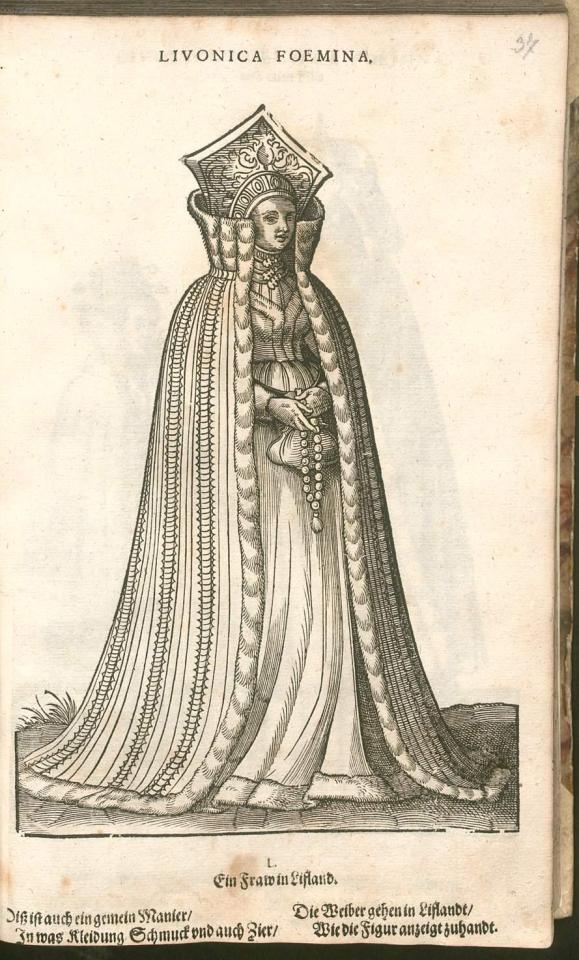
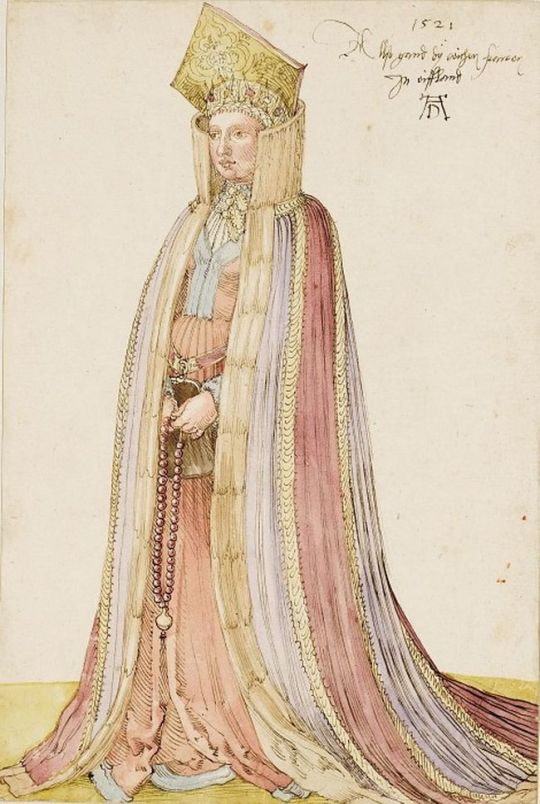
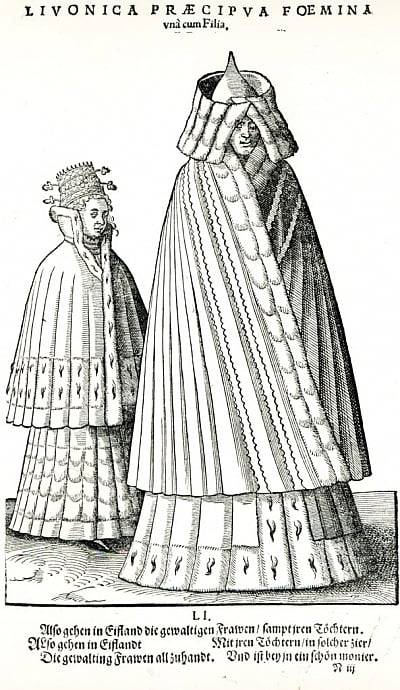
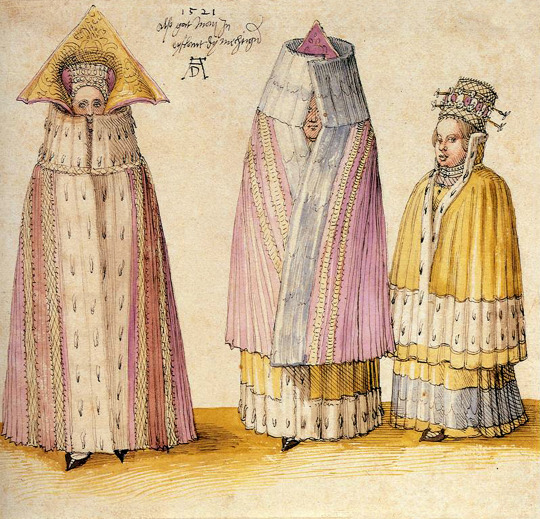
Even when costume book images are accurate portrayals of their source material, many of them lack the detail needed to identify seams, fabric types, or garment understructures. How do we deal with these problems when attempting to reconstruct what the people shown in these books actually wore?
What do we do about it?
I am not saying that we should discard these things completely as sources. Dress historians as respected as Patterns of Fashion author Janet Arnold and The Tudor Tailor authors Jane Malcolm and Ninya Mikhaila have used costume book illustrations. I definitely know less about 16th c. dress history than Jane and Ninya. I am just saying we shouldn't use them uncritically.
First, do some research on the costume book you're looking at. When was it created? Do the illustrations look suspiciously similar to those in other books? (Google image search and pinterest can be helpful for identifying this.) Did the creator, like Hans Weigel, have a particular bias they were advancing? Did they actually visit the cultures they portrayed? Christoph Weiditz actually traveled quite a bit, but he did not visit the British Isles, so his Irish and English women are probably based on someone else's art (Bond 2018). A lot of the scholarly publications about costume books are frustratingly paywalled, but some of them can be accessed for free via researchgate or academia.edu.
Avoid using copies when possible, even if the copies are more realistic-looking or more detailed art. As I discussed in the examples above, artists change things when they copy. Publication dates of copies can also be misleading in terms of dating clothing styles.
Find other sources such as: written descriptions from the time period, extant historical garments, more detailed art depicting similar fashions in related cultures, and art made by people from the culture you are studying. Period written descriptions can yield information about materials used, colors, and other details. Extant garments are your best source for information on cut and construction (unless you are lucky enough to have an extant tailor's manual from your period and culture). Detailed art depicting similar fashions can offer suggestions to fill in for missing information on construction, materials, and embellishments. Art created by the culture is valuable for identifying inaccuracies created by bigoted or ignorant artists.
Finally, remember that it's okay to not know everything. There are gaps in our knowledge about what people wore 500 years ago that will probably never be filled without a time machine. Sometimes you just have to make a plausible guess and move on. Don't let yourself get so paralyzed by doing research that you never complete the garment reconstruction/art/tumblr post you were doing the research for.
Bibliography:
Bond, K. L. (2018). Costume Albums in Charles V’s Habsburg Empire (1528-1549). https://doi.org/10.17863/CAM.25054
Dunlevy, Mairead (1989). Dress in Ireland. B. T. Batsford LTD, London.
Ilg, Ulrike. (2004). The Cultural Significance of Costume Books Sixteenth-Century Europe. In Catherine Richardson (ed.), Clothing Culture, 1350-1650 (p. 29-47). Ashgate.
McClintock, H. F. (1943). Old Irish and Highland Dress. Dundalgan Press, Dundalk.
McClintock, H. F. (1953). Some Hitherto Unpublished Pictures of Sixteenth Century Irish People, and the Costumes Appearing in Them. The Journal of the Royal Society of Antiquaries of Ireland, 83(2), 150-155. https://www.jstor.org/stable/25510871
Costume Books mentioned:
Amman, Jost. Gynaeceum, sive Theatrum mulierum.
The Costume Album of Christoph von Sternsee. not available on-line. Katherine Bond's research is your best source for this one.
Desprez, François. Recueil de la diversité des habits.
De Heere, Lucas. Corte Beschryvinghe van Engheland, Schotland, ende Irland.
Théâtre de tous les peuples et nations de la terre avec leurs habits et ornemens divers, tant anciens que modernes, diligemment depeints au naturel par Luc Dheere peintre et sculpteur Gantois.
Vecellio, Cesare, and Gratilianus, Sulstatius. Habiti antichi et moderni di tutto il Mondo di Cesare Vecellio.
Trachtenbuch des Christoph Weiditz
Weigel, Hans, and Amman, Jost. Habitus praecipuorum populorum, tam virorum quam foeminarum singulari arte depicti.
Kostüme der Männer und Frauen in Augsburg und Nürnberg, Deutschland, Europa, Orient und Afrika
Kostüme und Sittenbilder des 16. Jahrhunderts aus West- und Osteuropa, Orient, der Neuen Welt und Afrika
costume prints by an unknown artist, in the Bibliothèque nationale de France, Cabinet des Estampes. I cannot find this one online. image taken from McClintock 1953.
#dress history#historical fashion#art#16th century#17th century#historical costuming#historical dress#cw whorephobia#cw racism#irish dress#leine#irish mantle#reenactment#costume album
197 notes
·
View notes
Text
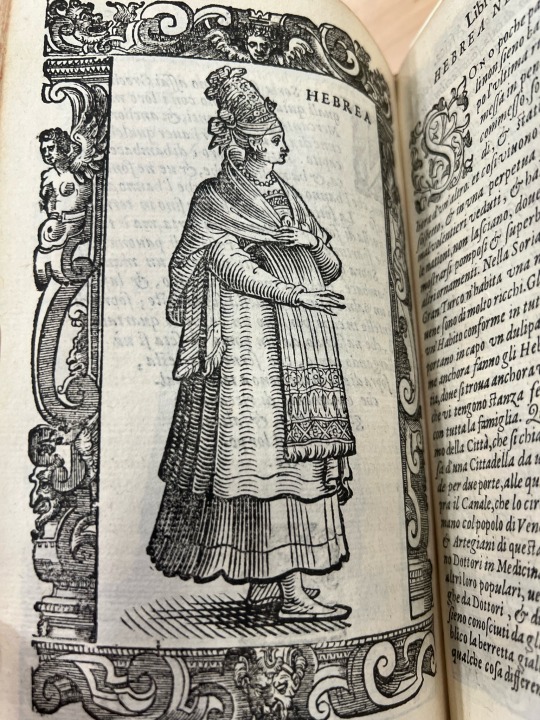
Woodcut illustration of a Jewish woman from Syria.
From De gli habiti antichi, et moderni di diuerse parti del mondo (1590) by Cesare Vecellio.
14 notes
·
View notes
Text
I get why people wanted these to be fire types, but I still think ghost works well with the concept

Gourgeist - Citrouillus habiti
Full print available here!
#pokemon#digital art#art#my art#nintendo#pokemon art#pkmn#pkmn art#grass type#ghost type#kalos#pkmn xy#pumpkaboo#pumpkaboo art#gourgeist#gourgeist art#pumpkin#plants#plant pokemon#ambulaphyta#fan art
21 notes
·
View notes
Text



Rough translation from arabic to english:
"you are the most beautiful boy, sunshine, I love you"
During their 5th month of officially dating. They're chilling at their house, as she's sleeping over during the weekend, and suddenly sprouts that out.
Should've made the habiti in arabic language then write it out how it would look in English but oh well.
#twstaddict17#choices hss#choices high school story#high school story#hss#mc hss#hss mc#solrin avana jaella (the og mc from my roster)#caleb x mc#caleb mitchell
6 notes
·
View notes
Text
As a Habitial Stimulant User-meaning I run on Concerta, Red Bull and/or coffee, and nicotine at all times- I think I am finally facing consequences for my actions bc I have the worst anxiety rn
3 notes
·
View notes
Text
Can I just get off this stupid country pleaseeee
If anybody wants to see my way of coping, there’s a channel called Habitial Linecrosser, he makes green screen videos of world news and shit and it’s funny. Love how he’s taking jabs at not only America but other countries as well.
That’s my way of coping, it helps.
2 notes
·
View notes
Text
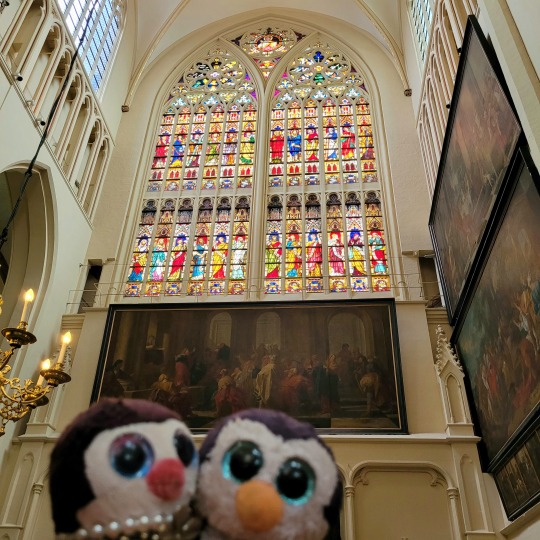

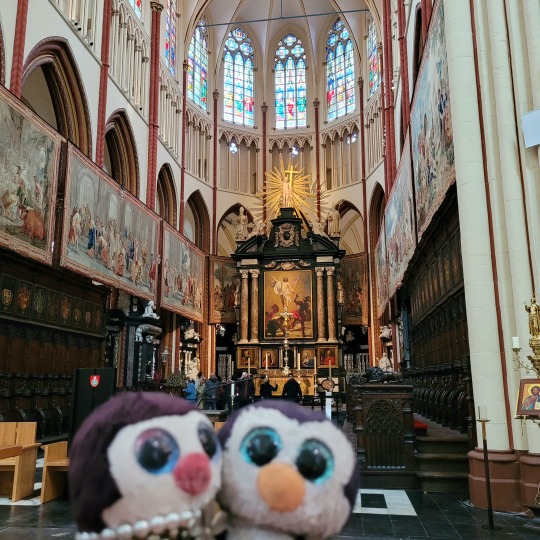
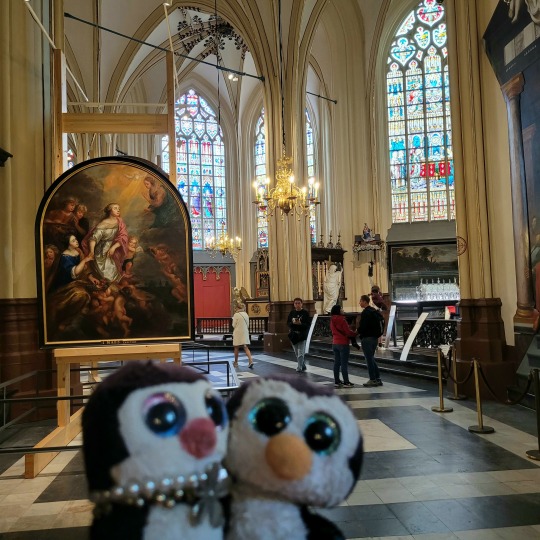
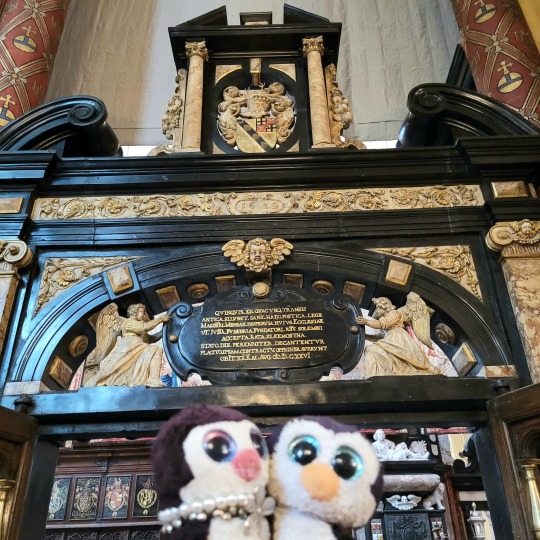

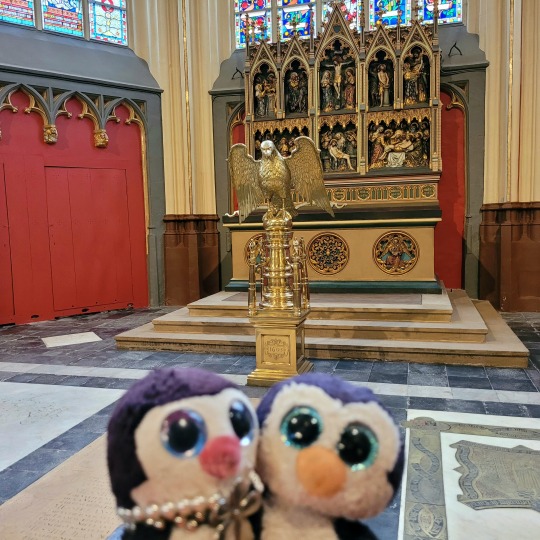

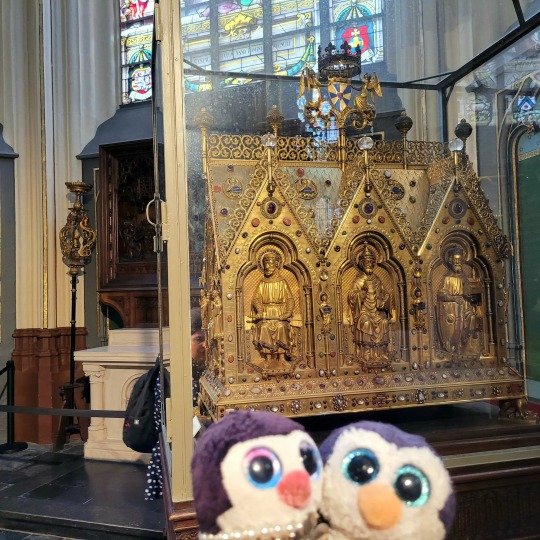
2023/08/05 Dentro de una de las iglesias, nos llamó la atención lo bien conservada que estaba. Las vidrieras lucían con todo su esplendor y las obras de arte son dignas de muchos museos. Saludamos a un primo que nos contó la historia del edificio.
Inside one of the churches, we were struck by how well preserved it was. The stained glass windows looked in all their splendor and the works of art are worthy of many museums. We greeted a cousin who told us the history of the building.
Google Translation into French: À l’intérieur d’une des églises, nous avons été frappés par son état de conservation. Les vitraux brillaient de toute leur splendeur et les œuvres d'art sont dignes de nombreux musées. Nous avons accueilli un cousin qui nous a raconté l'histoire de la bâtisse.
Google translation into Italian: All'interno di una delle chiese siamo rimasti colpiti dal suo stato di conservazione. Le vetrate brillavano in tutto il loro splendore e le opere d'arte sono degne di molti musei. Abbiamo accolto un cugino che ci ha raccontato la storia dell'edificio.
Google Translation into Portuguese: Dentro de uma das igrejas, ficamos impressionados com o seu estado de conservação. Os vitrais brilhavam em todo o seu esplendor e as obras de arte são dignas de muitos museus. Recebemos um primo que nos contou a história do prédio.
Google Translation into German: Im Inneren einer der Kirchen waren wir von ihrem Erhaltungszustand beeindruckt. Die Buntglasfenster erstrahlten in ihrer ganzen Pracht und die Kunstwerke sind vielen Museen würdig. Wir begrüßten einen Cousin, der uns die Geschichte des Gebäudes erzählte.
Google Translation into Albanisch: Brenda njërës prej kishave, na habiti se sa mirë ishte ruajtur. Dritaret me njolla dukeshin me gjithë shkëlqimin e tyre dhe veprat e artit janë të denja për shumë muze. U përshëndetëm me një kushëri që na tregoi historinë e ndërtesës.
Google Translation into Arabic: داخل إحدى الكنائس، أذهلنا مدى الحفاظ عليها جيدًا. تبدو النوافذ الزجاجية الملونة بكل روعتها وتستحق الأعمال الفنية وجودها في العديد من المتاحف. لقد استقبلنا ابن عم أخبرنا بتاريخ المبنى.
Google Translation into Armenian: Եկեղեցիներից մեկի ներսում մենք ապշեցինք, թե որքան լավ է այն պահպանվել: Վիտրաժները իրենց ողջ շքեղությամբ էին նայվում, իսկ արվեստի գործերը արժանի են բազմաթիվ թանգարանների։ Մենք ողջունեցինք զարմիկին, ով պատմեց շենքի պատմությունը:
Google Translation into Bengali: গির্জাগুলির একটির ভিতরে, এটি কতটা ভালভাবে সংরক্ষিত ছিল তা দেখে আমরা অবাক হয়েছিলাম। দাগযুক্ত কাচের জানালাগুলি তাদের সমস্ত জাঁকজমক দেখায় এবং শিল্পের কাজগুলি অনেক যাদুঘরের যোগ্য। আমরা একজন চাচাতো ভাইকে অভ্যর্থনা জানালাম যিনি আমাদের বিল্ডিংয়ের ইতিহাস বলেছিলেন।
Google Translation into Bulgarian: Вътре в една от църквите бяхме поразени от това колко добре е запазена. Витражите изглеждаха в целия си блясък, а произведенията на изкуството са достойни за много музеи. Поздравихме братовчед, който ни разказа историята на сградата.
Google Translation into Czech: Uvnitř jednoho z kostelů nás zarazilo, jak je zachovalý. Vitráže vypadaly v celé své nádheře a umělecká díla jsou hodna mnoha muzeí. Pozdravili jsme bratrance, který nám řekl historii budovy.
Google Translation into Simplified Chinese: 在其中一座教堂内,我们对其保存完好的状态感到震惊。 彩色玻璃窗看起来非常辉煌,艺术品值得许多博物馆收藏。 我们迎接了一位表弟,他向我们讲述了这座建筑的历史。
Google Translation into Korean: 교회 중 한 곳의 내부가 얼마나 잘 보존되어 있는지 보고 우리는 놀랐습니다. 스테인드 글라스 창문은 그 화려함을 모두 보여 주었고 예술 작품은 많은 박물관에 소장될 가치가 있습니다. 우리는 건물의 역사를 말해 준 사촌에게 인사를 했습니다.
Google Translation into Croatian: Unutar jedne od crkava bili smo iznenađeni koliko je dobro očuvana. Vitraji su izgledali u svoj svojoj raskoši, a umjetnička djela dostojna su brojnih muzeja. Pozdravili smo rođaka koji nam je ispričao povijest zgrade.
Google Translation into Danish Inde i en af kirkerne blev vi slået af, hvor velbevaret den var. Glasmosaikerne så ud i al deres pragt, og kunstværkerne er mange museer værd. Vi hilste på en fætter, der fortalte os bygningens historie.
Google Translation into Slovak: Vo vnútri jedného z kostolov nás zarazilo, aký je zachovalý. Vitráže vyzerali v celej svojej kráse a umelecké diela sú hodné mnohých múzeí. Pozdravili sme bratranca, ktorý nám porozprával históriu budovy.
Google Translation into Slovenian: Znotraj ene od cerkva nas je presenetilo, kako dobro je ohranjena. Vitraži so bili videti v vsem svojem sijaju in umetnine so vredne številnih muzejev. Pozdravili smo bratranca, ki nam je povedal zgodovino stavbe.
Google Translation into Estonian: Ühe kiriku sees rabasime, kui hästi see oli säilinud. Vitraažaknad nägid välja kogu oma hiilguses ja kunstiteosed on paljude muuseumide väärilised. Tervitasime nõbu, kes rääkis meile hoone ajaloost.
Google Translation into Suomi: Yhdessä kirkossa olimme hämmästyneitä siitä, kuinka hyvin se oli säilynyt. Lasimaalaukset näyttivät kaikessa loistossaan ja taideteokset ovat monen museon arvoisia. Tervehdimme serkkua, joka kertoi meille rakennuksen historiasta.
Google Translation into Georgian: ერთ-ერთი ეკლესიის შიგნით გაკვირვებული ვიყავით, რამდენად კარგად იყო შემონახული. ვიტრაჟები მთელი თავისი ბრწყინვალებით გამოიყურებოდა და ხელოვნების ნიმუშები მრავალი მუზეუმის ღირსია. მივესალმეთ ბიძაშვილს, რომელმაც შენობის ისტორია გვიამბო.
Google Translation into Greek: Μέσα σε μια από τις εκκλησίες, μας έκανε εντύπωση το πόσο καλά διατηρημένο ήταν. Τα βιτρό έμοιαζαν με όλο τους το μεγαλείο και τα έργα τέχνης είναι αντάξια πολλών μουσείων. Χαιρετίσαμε έναν ξάδερφο που μας είπε την ιστορία του κτιρίου.
Google Translation into Guarani: Peteĩ tupao ryepýpe, oremondýi mba’éichapa oñeñongatu porã. Umi vidriera ojesareko opavave esplendor-pe ha umi obra de arte digno heta museo-pe. Romomaitei peteĩ primo omombe’úva oréve pe edificio rembiasakue.
Google Translation into Hawaiian: I loko o kekahi o nā halepule, ua ʻike mākou i ka maikaʻi o ka mālama ʻana. ʻIke ʻia nā puka aniani ʻeleʻele i ko lākou nani a kūpono nā hana noʻeau i nā hale hōʻikeʻike he nui. Aloha mākou i kekahi hoahānau nāna i haʻi mai iā mākou i ka moʻolelo o ka hale.
Google Translation into Hebrew: בתוך אחת הכנסיות, הופתענו מכמה שהשתמרה היטב. חלונות הוויטראז' נראו במלוא הדרו ויצירות ה��מנות ראויות למוזיאונים רבים. בירכנו בן דוד שסיפר לנו את ההיסטוריה של הבניין.
Google Translation into Hindi: एक चर्च के अंदर, हम यह देखकर दंग रह गए कि यह कितनी अच्छी तरह संरक्षित था। रंगीन कांच की खिड़कियाँ अपनी पूरी भव्यता के साथ दिखती थीं और कला के कार्य कई संग्रहालयों के योग्य हैं। हमने एक चचेरे भाई का स्वागत किया जिसने हमें इमारत का इतिहास बताया।
Google Translation into Hungarian: Az egyik templom belsejében megdöbbentett minket, hogy milyen jól megőrzött. Az ólomüveg ablakok teljes pompájukban látszottak, a műalkotások pedig számos múzeumhoz méltóak. Köszöntöttünk egy unokatestvért, aki elmesélte az épület történetét.
Google Translation into Indonesian: Di dalam salah satu gereja, kami terkejut melihat betapa terpeliharanya gereja tersebut. Jendela kaca patri tampak dengan segala kemegahannya dan karya seninya layak untuk disimpan di banyak museum. Kami menyapa sepupu yang menceritakan kepada kami sejarah bangunan tersebut.
Google Translation into Japanese: 教会の 1 つで、私たちはその保存状態の良さに驚きました。 ステンドグラスの窓は素晴らしく、その芸術作品は多くの美術館に値するものでした。 私たちはいとこに挨拶して、建物の歴史を教えてくれました。
Google Translation into Kyrgyz: Чиркөөлөрдүн биринин ичинде анын канчалык жакшы сакталганы бизди таң калтырды. Витраждар бардык кооздугу менен көрүнгөн жана искусство чыгармалары көптөгөн музейлерге татыктуу. Имараттын тарыхын айтып берген жеңе менен учураштык.
Google Translation into Latvian: Vienā no baznīcām mūs pārsteidza, cik labi tā bija saglabājusies. Vitrāžas izskatījās visā savā krāšņumā, un mākslas darbi ir daudzu muzeju cienīgi. Sasveicinājāmies ar brālēnu, kura pastāstīja par ēkas vēsturi.
Google Translation into Malayalam: ഒരു പള്ളിയുടെ ഉള്ളിൽ, അത് എത്ര നന്നായി സംരക്ഷിക്കപ്പെട്ടിരിക്കുന്നു എന്നത് ഞങ്ങളെ ഞെട്ടിച്ചു. സ്റ്റെയിൻഡ് ഗ്ലാസ് ജാലകങ്ങൾ അവയുടെ എല്ലാ പ്രൗഢിയോടെയും കാണപ്പെട്ടു, കലാസൃഷ്ടികൾ നിരവധി മ്യൂസിയങ്ങൾക്ക് യോഗ്യമാണ്. കെട്ടിടത്തിന്റെ ചരിത്രം പറഞ്ഞുതന്ന ഒരു ബന്ധുവിനെ ഞങ്ങൾ അഭിവാദ്യം ചെയ്തു.
Google Translation into Malay: Di dalam salah satu gereja, kami terpegun dengan betapa terpeliharanya ia. Tingkap kaca berwarna kelihatan dalam semua kemegahan mereka dan karya seni layak untuk banyak muzium. Kami menyapa seorang sepupu yang memberitahu kami sejarah bangunan itu.
Google Translation into Malagasy: Tao anatin’ny iray tamin’ireo fiangonana, dia gaga izahay noho ny fitahirizana tsara azy io. Ny varavarankelin'ny fitaratra voaloto dia nijery tamin'ny famirapiratany rehetra ary mendrika ho an'ny tranombakoka maro ny sangan'asa. Niarahaba ny zanak’olo-mpiray tam-po taminy izahay, izay nilaza taminay ny tantaran’ilay trano.
Google Translation into Mongolian: Нэгэн сүм дотор түүнийг хэр сайн хадгалсан нь биднийг гайхшруулсан. Будсан шилэн цонхнууд нь бүх л сүр жавхлангаараа харагдаж байсан бөгөөд урлагийн бүтээлүүд олон музейн үнэ цэнэтэй юм. Барилгын түүхийг өгүүлсэн үеэл ахтай мэндэллээ.
Google Translation into Dutch: Binnen in een van de kerken viel het ons op hoe goed bewaard gebleven het was. De glas-in-loodramen zagen er in al hun pracht uit en de kunstwerken zijn vele musea waardig. We begroetten een neef die ons de geschiedenis van het gebouw vertelde.
Google Translation into Nepali: एउटा मण्डली भित्र, यो कत्ति राम्रोसँग संरक्षित थियो भनेर हामी छक्क पर्यौं। दागका काँचका झ्यालहरू तिनीहरूको सबै वैभवमा देखिन्थे र कलाका कार्यहरू धेरै संग्रहालय���रूको लागि योग्य छन्। हामीले भवनको इतिहास बताउने चचेरे भाईलाई अभिवादन गर्यौं।
Google Translation into Norwegian: Inne i en av kirkene ble vi slått av hvor godt bevart den var. Glassmaleriene så ut i all sin prakt og kunstverkene er mange museer verdig. Vi hilste på en fetter som fortalte oss historien til bygningen.
Google Translation into Panjabi: ਇੱਕ ਚਰਚ ਦੇ ਅੰਦਰ, ਅਸੀਂ ਇਸ ਗੱਲ ਤੋਂ ਹੈਰਾਨ ਹੋ ਗਏ ਕਿ ਇਹ ਕਿੰਨੀ ਚੰਗੀ ਤਰ੍ਹਾਂ ਸੁਰੱਖਿਅਤ ਸੀ। ਰੰਗੀਨ ਸ਼ੀਸ਼ੇ ਦੀਆਂ ਖਿੜਕੀਆਂ ਆਪਣੀ ਸਾਰੀ ਸ਼ਾਨ ਵਿਚ ਦਿਖਾਈ ਦਿੰਦੀਆਂ ਸਨ ਅਤੇ ਕਲਾ ਦੇ ਕੰਮ ਬਹੁਤ ਸਾਰੇ ਅਜਾਇਬ ਘਰਾਂ ਦੇ ਯੋਗ ਹਨ. ਅਸੀਂ ਇੱਕ ਚਚੇਰੇ ਭਰਾ ਦਾ ਸਵਾਗਤ ਕੀਤਾ ਜਿਸ ਨੇ ਸਾਨੂੰ ਇਮਾਰਤ ਦਾ ਇਤਿਹਾਸ ਦੱਸਿਆ।
Google Translation into Pashtun: د یوې کلیسا دننه، موږ د دې له امله حیران شو چې دا څومره ښه ساتل شوی و. د رنګ شوي شیشې کړکۍ په خپل ټول ښکلا کې لیدل کیږي او د هنر کارونه د ډیری موزیمونو وړ دي. موږ یو د تره زوی ته ښه راغلاست ووایه چې موږ ته یې د ودانۍ تاریخ وویل.
Google Translation into Persian: در داخل یکی از کلیساها، ما از اینکه چقدر خوب محافظت شده بود، شگفت زده شدیم. شیشه های رنگی با تمام شکوه و عظمت خود به نظر می رسید و آثار هنری شایسته موزه های بسیاری هستند. به پسر عمویی که تاریخچه ساختمان را برایمان گفت احوالپرسی کردیم.
Google Translation into Polish: Wewnątrz jednego z kościołów uderzyło nas, jak dobrze był zachowany. Witraże prezentowały się w całej okazałości, a dzieła sztuki zasługują na miano wielu muzeów. Przywitaliśmy kuzyna, który opowiedział nam historię budynku.
Google Translation into Romanian: În interiorul uneia dintre biserici, ne-a surprins cât de bine conservată era. Vitraliile arătau în toată splendoarea lor și operele de artă sunt demne de multe muzee. Am salutat un văr care ne-a povestit istoria clădirii.
Google Translation into Russian: Внутри одной из церквей мы были поражены тем, насколько хорошо она сохранилась. Витражи выглядели во всем своем великолепии, а произведения искусства достойны многих музеев. Мы приветствовали двоюродного брата, который рассказал нам историю здания.
Google Translation into Serbian: Унутар једне од цркава били смо запањени колико је добро очувана. Витражи су изгледали у свом свом сјају и уметничка дела су достојна многих музеја. Поздравили смо рођака који нам је испричао историју зграде.
Google Translation into Swedish: Inne i en av kyrkorna slogs vi av hur välbevarad den var. Glasmålningarna såg ut i all sin prakt och konstverken är värda många museer. Vi hälsade på en kusin som berättade byggnadens historia.
Google Translation into Sundanese: Di jero salah sahiji garéja, urang katénjo ku cara dilestarikan éta. Jandéla kaca patri katingali dina sagala kamulyaan sareng karya seni pantes seueur musium. Urang dipapag ka misan anu ngawartoskeun kami sajarah wangunan.
Google Translation into Tagalog: Sa loob ng isa sa mga simbahan, nagulat kami sa kung gaano ito napreserba. Ang mga stained glass na bintana ay tumingin sa lahat ng kanilang ningning at ang mga gawa ng sining ay karapat-dapat sa maraming museo. Binati namin ang isang pinsan na nagsabi sa amin ng kasaysayan ng gusali.
Google Translation into Thai: ภายในโบสถ์แห่งหนึ่ง เรารู้สึกประทับใจกับการอนุรักษ์ไว้อย่างดี หน้าต่างกระจกสีดูงดงามตระการตาและผลงานศิลปะก็คู่ควรแก่พิพิธภัณฑ์หลายแห่ง เราทักทายลูกพี่ลูกน้องที่เล่าประวัติความเป็นมาของอาคารให้เราฟัง
Google Translation into Telugu: ఒక చర్చి లోపల, అది ఎంత బాగా సంరక్షించబడిందో చూసి మేము ఆశ్చర్యపోయాము. స్టెయిన్డ్ గ్లాస్ కిటికీలు వాటి వైభవంగా కనిపించాయి మరియు కళాఖండాలు అనేక మ్యూజియంలకు అర్హమైనవి. భవన చరిత్ర చెప్పిన బంధువును పలకరించాం.
Google Translation into Turkish: Kiliselerden birinin içinde ne kadar iyi korunmuş olduğuna hayran kaldık. Tüm ihtişamıyla görünen vitrayları ve sanat eserleri birçok müzeye layıktır. Bize binanın tarihini anlatan bir kuzenimizle karşılaştık.
Google Translation into Ukrainian: Всередині однієї з церков ми були вражені тим, наскільки добре вона збер��глася. Вітражі виглядали у всій своїй пишноті, а витвори мистецтва гідні багатьох музеїв. Ми привітали двоюрідного брата, який розповів нам історію будівлі.
Google Translation into Urdu: گرجا گھروں میں سے ایک کے اندر، ہمیں یہ دیکھ کر حیرت ہوئی کہ یہ کتنی اچھی طرح سے محفوظ ہے۔ داغدار شیشے کی کھڑکیاں اپنی پوری شان و شوکت میں نظر آتی تھیں اور فن کے کام بہت سے عجائب گھروں کے لائق ہیں۔ ہم نے ایک کزن کو سلام کیا جس نے ہمیں عمارت کی تاریخ بتائی۔
Google Translation into Uzbek: Cherkovlardan birining ichida uning qanchalik yaxshi saqlanganligi bizni hayratda qoldirdi. Vitrajlar o'zining ajoyibligi bilan ko'rinardi va san'at asarlari ko'plab muzeylarga loyiqdir. Bizga binoning tarixini aytib bergan amakivachcha bilan salomlashdik.
Google Translation into Vietnamese: Bên trong một trong những nhà thờ, chúng tôi rất ấn tượng vì nó được bảo tồn rất tốt. Các cửa sổ kính màu trông hết sức lộng lẫy và các tác phẩm nghệ thuật xứng đáng được đưa vào nhiều viện bảo tàng. Chúng tôi chào một người anh họ đã kể cho chúng tôi nghe về lịch sử của tòa nhà.
#Brujas#Brugge#Bruges#Belgica#Belgium#Inside#Church#Architecture#Sculpture#Art#Windows#Paintings#Baroque#PolloNegroSkyWalker#TravelBlogger#Wanderlust#CoupleGoals#GoodVibes#Plushies#instaGood#Maharashtra#ペンギン
8 notes
·
View notes
Text
WIP Wednesday: "As the clay..."
youtube
We are in Elul and I am thinking about the upcoming High Holy Days, and one of my favorite Yom Kippur poems and melodies is on my mind. Last year I made an aborted attempt to translate it into English in such a way that it can still be sung to the melody I know. This year I'm making the attempt again. I have two verses translated so far. Here is the first verse:
כִּי הִנֵּה כַחֹֽמֶר בְּיַד הַיּוֹצֶרֶת Ki hinei ka-ḥomer be-yad ha-yotzeres, בִּרְצוֹתָהּ מַרְחִיבָה וּבִרְצוֹתָהּ מְקַצֶּרֶת Birtsosah mar'ḥi'vah uvirtzosah mekatzeres כֵּן אֲנַחְנוּ בְיָדֵך חֶסֶד נוֹצֶרֶת Ken anaḥnu be-yadeḥ ḥesed notseres לַבְּרִית הַבִּיטִי וְאַל תִּפְנִי לַיֵּצֶר La-bris habiti ve-al tifni la-yeitzer.
And here is my artistic translation of the above verse:
As the clay wet and formless in the potter's hand — by her will to be thickened or by her will to be thinned — So in your hands, O God, formless now we stand. Please remember your covenant and forget our sin!
#puck writes#wip wednesday#being jewish on main#yom kippur#piyyut#translation#poetry#videos#Youtube#edit to add: haha it's Tuesday but i was impatient
6 notes
·
View notes
Text
写真詩集『New Habitations: from North to East 11 years after 3.11』刊行のお知らせ

どこまでも広くて、青々とうつくしい
破壊のあと、その分厚い手で立ち上げてきたのは
誰にも思いも寄らなかった風景
ー New Habitiations サイトより
東日本大震災から11 年目に撮られた写真と、11 年の間に語られた土地の言葉。被災地の現在と過去が織り成す、「あたらしい風景」。
この度、「住むの風景」初の書籍、『New Habitations from North to East: 11 years after 3.11』(写真|トヤマタクロウ、詩|瀬尾夏美)を、YYY PRESSより刊行することとなりました。9月下旬より、全国の各書店や通販サイト等で販売する予定です。 このプロジェクトで岩手県北を旅していた時に、瀬尾さんと何か作れないかと話してから約1年半。写真家のトヤマタクロウさん、デザイナーの米山菜津子さんたちと旅を重ねて、一冊の写真詩集が生まれました。ぜひお手に取ってご覧いただければ幸いです。
ー
『New Habitations from North to East: 11 years after 3.11』 写真|トヤマタクロウ 詩|瀬尾夏美 装丁|米山菜津子 編集|柴原聡子 翻訳|大久保玲奈、サム・ベット YYY PRESS刊
言語 日本語(一部日英併記)※本編の詩の英語版別紙も一部発行予定 上製 312 頁 横188 × 縦263 mm 定価=本体5,500 円+税 ツバメ出版流通取扱 ISBN 978-4-908254-10-9 C0070 ¥5500E 9月末刊行予定
Ja https://newhabitations.com/new-habitations-book/
En https://newhabitations.com/en/new-habitations-book/
6 notes
·
View notes